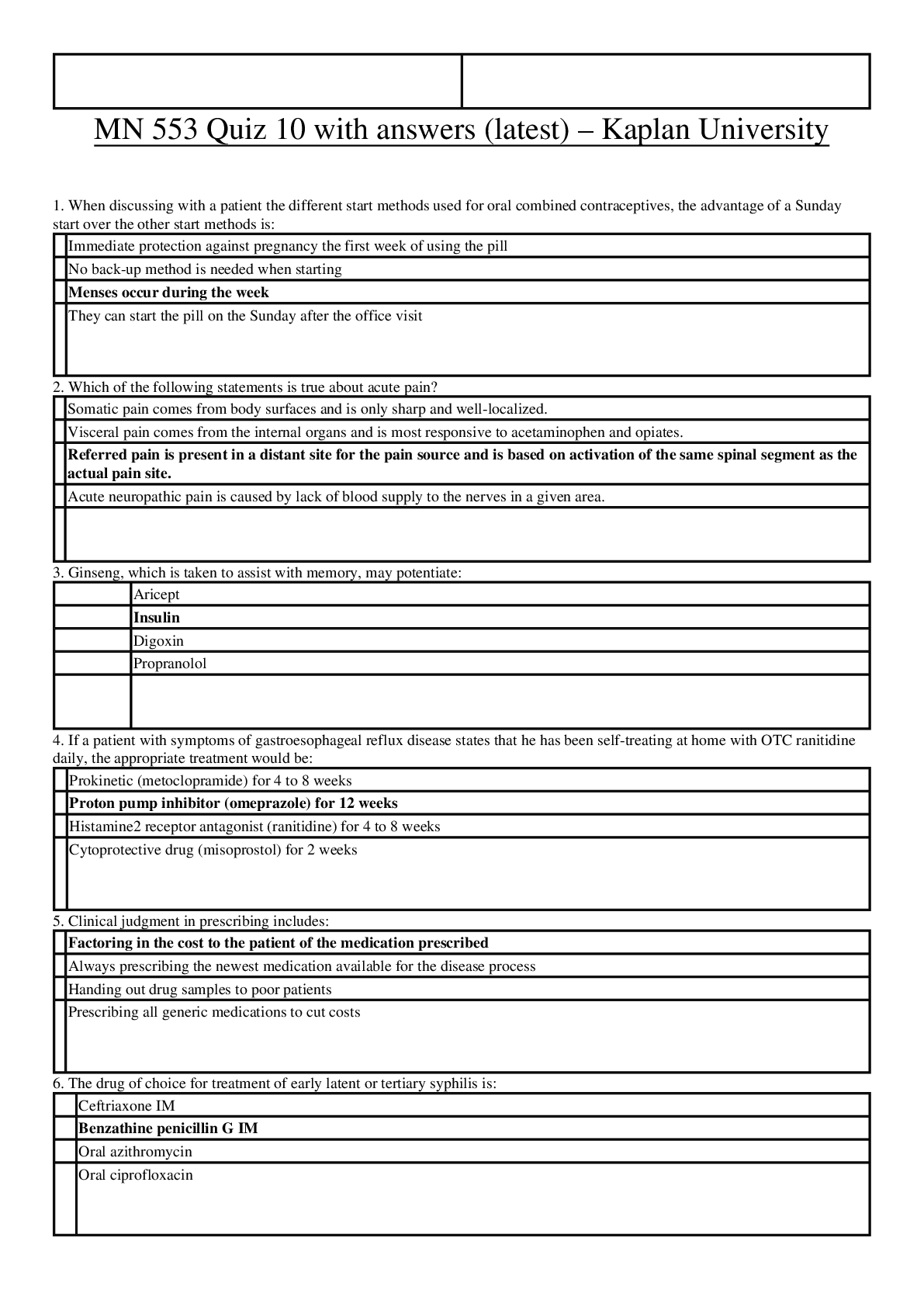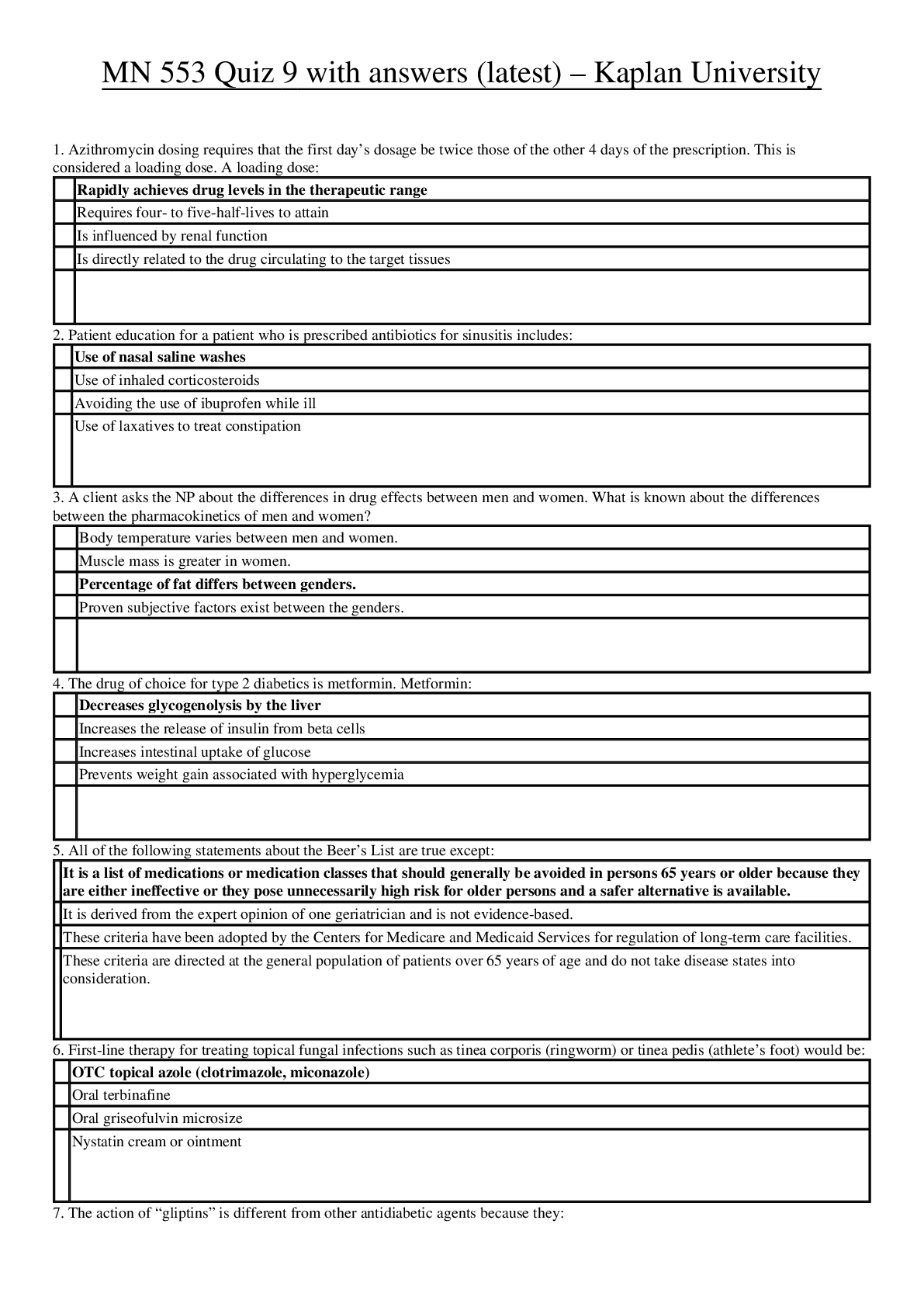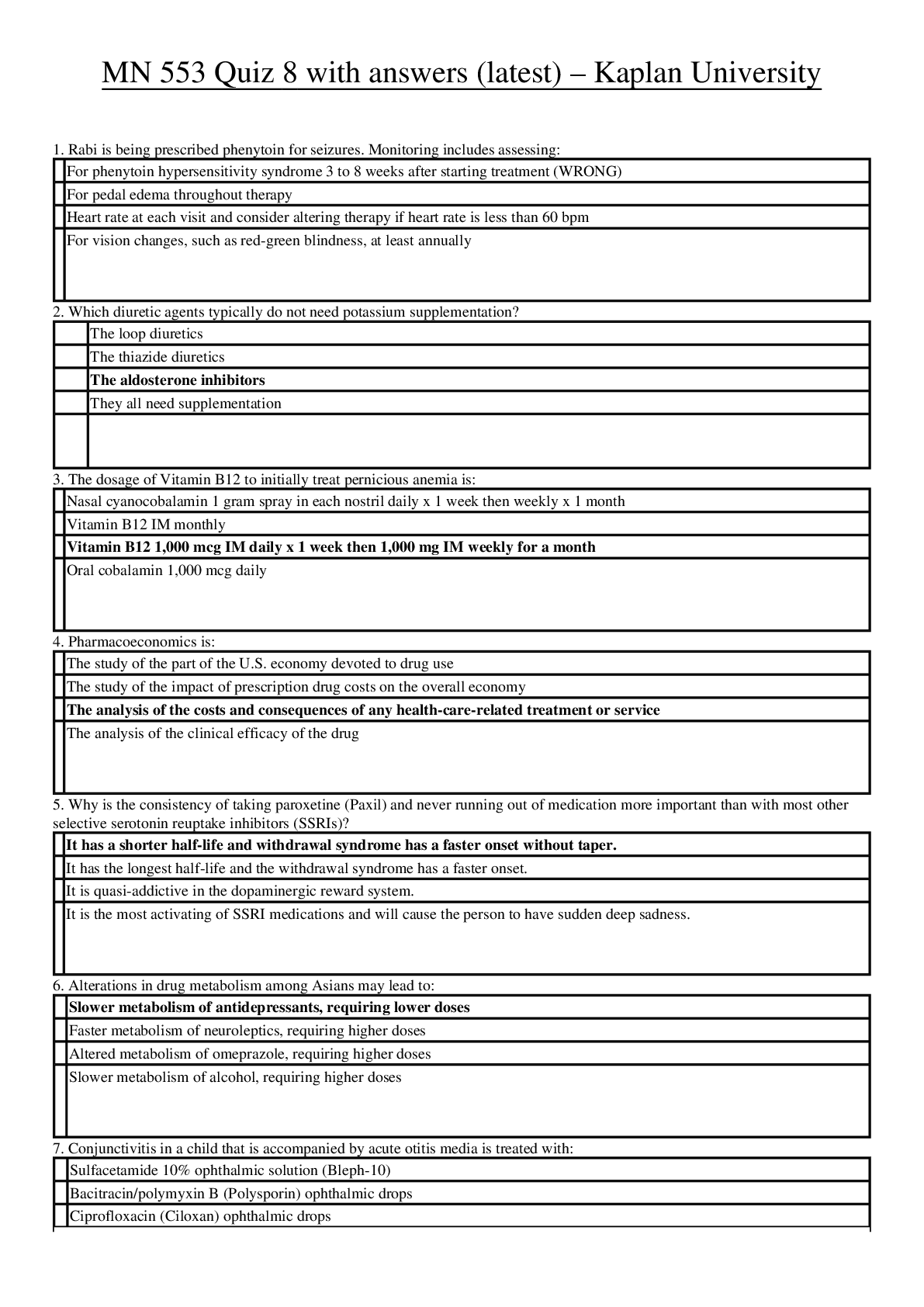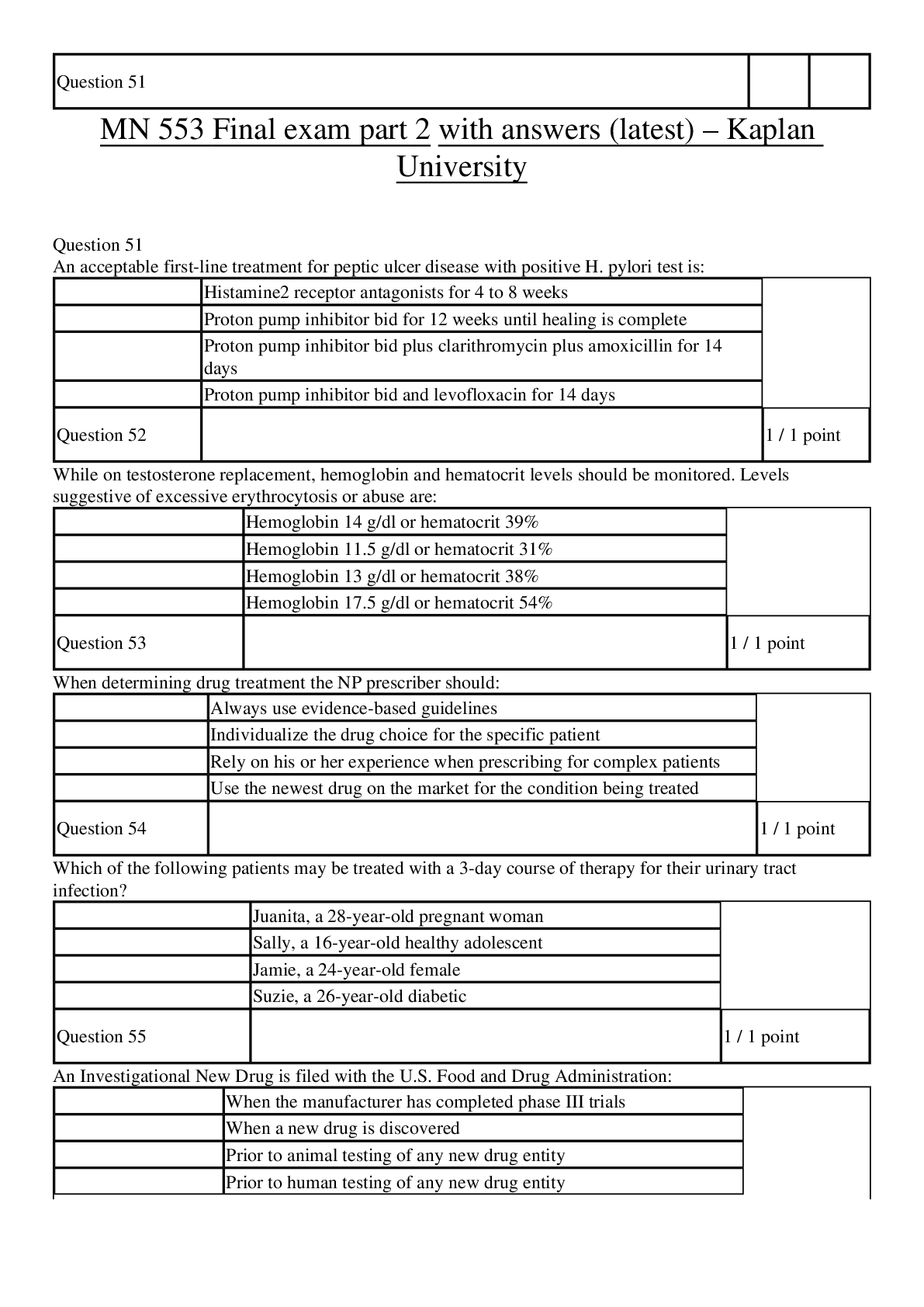*NURSING > EXAM > MN 551 Unit 6 exam 2020 : Disorders of the Gastrointestinal and Genitourinary Systems in Primary Car (All)
MN 551 Unit 6 exam 2020 : Disorders of the Gastrointestinal and Genitourinary Systems in Primary Care – Kaplan University | MN551 Unit 6 exam 2020 : Disorders of the Gastrointestinal and Genitourinary Systems in Primary Care
Document Content and Description Below
MN 551 Unit 6 exam 2020 : Disorders of the Gastrointestinal and Genitourinary Systems in Primary Care – Kaplan University 1. A 35yearold female patient is seen in the clinic complaining of ... abdominal pain. Which of the following should be included in the history and physical exam? (Points : 2) Digital rectal exam, Pelvic exam, Sexual history, All of the above A 72 yo patient with a long standing history of chronic nausea and vomiting but a near-insatiable appetite has had her symptoms attributed to an enzyme deficiency. Hiatal hernia – protrusion of the stomach or regurgitation of the stomach contents into the esphagus 2. A patient is seen in the office and is complaining of constipation. The patient lists all of the following medications. Which drug could be responsible for the constipation? (Points : 2) Multivitamin, Magnesium hydroxide, PeptoBismol, Ibuprofen 3. A patient with complaints of diarrhea is seen. Which of the following should be included on the differential diagnosis list for a patient with diarrhea? (Points : 2) Gastroenteritis, Inflammatory bowel disease, Lactase deficiency, All of the above 4. Mr. J. K., 38 years old, is 5 feet 8 inches tall and weighs 189 pounds. He reports that he has had intermittent heartburn for several months for which he takes Tums with temporary relief. He has been waking during the night with a burning sensation in his chest. Which additional information would lead you to believe that gastroesophageal reflux disease (GERD) is the cause of his pain? (Points : 2) The pain seems better when he smokes to relieve his nerves. Coffee and fried foods do not bother him. He awakens at night coughing with a bad taste in his mouth. All of the above 5. A 29yearold Englishman is seen in the office with complaints of pain in his chest and belly for 2 weeks. He gets temporary relief from Alka Seltzer. The burning pain wakes him at night and radiates up into his chest. Which factor favors a diagnosis of gastric ulcer? (Points : 2) His gender His age His use of Alka Seltzer 6. Which of the following is most effective in diagnosing appendicitis? (Points : 2) History and physical Sedimentation rate Kidneys, ureter, bladder (KUB) radiograph Complete blood cell (CBC) count with differential 7. Which of the following is associated with celiac disease (celiac sprue)? (Points : 2) Malabsorption Constipation Rectal bleeding Esophageal ulceration 8. A 45yearold patient presents with a chief complaint of generalized abdominal pain. Her physical exam is remarkable for left lower quadrant (LLQ) tenderness. Which of the following should be considered in the differential diagnosis at this time? (Points : 2) Endometriosis Colon cancer Diverticulitis All of the above 9. A 46yearold female is seen in the clinic with abdominal pain. Which of the following tests is essential for this patient? (Points : 2) Complete blood cell (CBC) count with differential, Urine hCG, Barium enema, Computed tomography (CT) of the abdomen 10. A 25yearold accountant is seen in the clinic complaining ofcrampy abdominal pain after meals. She is often constipated and takes laxatives. Following this, she has diarrhea for a couple of days. She temporarily feels better after a bowel movement. She states she is embarrassed by flatulence and has abdominal distension. She has had no weight loss or blood in her stool. This problem has gone on for about 6 months. What should the next step be? (Points : 2) Obtain a complete history. Order a barium enema. Schedule a Bernstein’s test. Prescribe a trial of antispasmodics. 11. A 28yearold patient is seen in the clinic with colicky abdominal pain, particularly with meals. She has frequent constipation, flatulence, and abdominal distension. Which of the data make a diagnosis of diverticulitis unlikely? (Points : 2) Her age, Frequent constipation Flatulence Colicky abdominal pain 12. A 28yearold patient is seen with complaints of diarrhea. Which of the following questions would help the clinician establish the diagnosis of irritable bowel syndrome? (Points : 2) Feels relief after a bowel movement Sometimes is constipated Does not defecate in the middle of the night All of the above 13. A patient is diagnosed with gastroesophageal reflux disease (GERD), and his endoscopic report reveals the presence of Barrett’s epithelium. Which of the following information should the clinician include in the explanation of the pathology report? (Points : 2) This is a premalignant tissue. This tissue is resistant to gastric acid. This tissue supports healing of the esophagus. All of the above 14. Which of the following dietary information should be given to a patient with gastroesophageal reflux disease (GERD)? (Points : 2) Eliminate coffee. Drink peppermint tea to relieve stomach distress. Recline and rest after meals. Limit the amount of antacids. Proton pump inhibitors, avoiding large meals, and remaining upright after meals Which of the following meals or snacks is most likely to exacerbate the patient’s signs and symtoms of deficiency in brush border enzymes 15. The patient with gastroesophageal reflux disease (GERD) should be instructed to eliminate which of these activities? (Points : 2) Swimming Weight lifting Golfing Walking 16. A patient is diagnosed with Giardia after a backpacking trip in the mountains. Which of the following would be the appropriate treatment? (Points : 2) Vancomycin Penicillin Metronidazole Bactrim 3/5 10/6/2015 MN555: Primary Care Across the Adult Age Continuum II 17. A 22yearold is seen complaining of vague belly pain. This type of pain is seen at what point in appendicitis? (Points : 2) Very early, 3 to 4 hours after perforation, Late in inflammation, Appendicitis never presents with vague pain. 18. The clinician suspects the patient has a peptic ulcer. Which of the following items on the history would lead the clinician to this conclusion? (Points : 2) Use of NSAIDs Cigarette smoker Alcohol (ETOH) consumption All of the above 19. A patient is seen and a urine sample is taken. The urine dipstick reveals a high level of bilirubin, and the urine is dark colored. Which of the following could be a cause of this problem? (Points : 2) Increased breakdown of red blood cells Inadequate hepatocyte function Biliary obstruction All of the above 20. A 21yearold student presents with a chief complaint of fatigue, headache, anorexia, and a runny nose, all of which began about 2 weeks ago. She started taking vitamins and overthecounter (OTC) cold preparations but feels worse. The smell of food makes her nauseated. Her boyfriend had mononucleosis about a month ago, and she wonders if she might have it also. An examination reveals cervical adenopathy and enlarged liver and spleen. Which of the following laboratory tests would be most helpful in the differential diagnosis at this point? (Points : 2) Stool culture Liver enzymes AntiHDV (antibody to hepatitis D virus) Thyroidstimulating hormone (TSH) 21. On further questioning, the 21yearold patient with the chief complaints of fatigue, headache, anorexia, and a runny nose explains that she is sexually active only with her boyfriend, does not use injectable drugs, and works as an aide in a daycare center. Which of the following tests would be most helpful in confirming your diagnosis? (Points : 2) HAV IgM HAV IgG AntiHAcAg AntiHAsAg 22. A patient is seen in the clinic with right upper quadrant (RUQ) pain that is radiating to the middle of the back. The clinician suspects acute cholelithiasis. The clinician should expect which of the following laboratory findings? (Points : 2) Decreased alanine aminotransferase (ALT) and aspartate aminotransferase (AST) Elevated alkaline phosphatase Elevated indirect bilirubin Decreased white blood cell (WBC) count 23. The patient has acute pancreatitis with 7 of the diagnostic criteria from Ranson’s Criteria. In order to plan care, the clinician understands that this criteria score has which of the following meanings? (Points : 2) A high mortality rate An increased chance of recurrence A 7% chance of the disease becoming chronic All of the above 24. A patient is seen in the office with complaints of six to seven liquid bowel movements per day. Which of the following assessment findings would lead the clinician to a diagnosis of inflammatory bowel disease? (Points : 2) Intermittent constipation with periods of diarrhea Awakens at night with diarrhea History of international travel All of the above 25. Which of the following is part of the treatment plan for the patient with irritable bowel syndrome? (Points : 2) Highfiber diet Tylenol with codeine Daily laxatives All of the above data Question 1. Chronic anxiety and stress contribute to ulcers. Which of the following effects of the sympathetic nervous system is most responsible for this effect? Inhibition of the actions of Brunner glands Overstimulation of the oxyntic glands Suppression of cholecystokinin Inflammation of the parotid glands Question 2. Which of the following patients is most clearly displaying the signs and symptoms of IBD? A 32-year-old mother who complains of intermittent abdominal pain that persists even after defecation. A 51-year-old male who states that his stomach pain is in his lower abdomen, “comes and goes,” and “feels more like a cramp than a dull ache.” A 44-year-old man who is under great financial stress and who states that his lower abdominal pain is much worse at night than during the day. A 24-year-old man who has a stressful job but whose diarrhea and cramping do not worsen during periods of high stress. Question 3. A 24-year-old woman undergoing a premarital screening test is found to have elevated levels of AST, ALT, and IgG, but no antibody-specific markers for viral hepatitis. A liver biopsy reveals inflammation and cellular damage. Which of the following treatments is most likely to be effective for her? Lamivudine Peginterferon and ribavirin Interferon-alfa-2b Corticosteroids and immunosuppressant drugs Question 4. Which of the following statements best captures an aspect of the process of fat digestion and absorption? Ingested triglycerides are broken down into absorbable form by gastric lipase. Simple forms of fats are absorbed in the upper jejunum. Long-chain fatty acids are absorbed more readily than medium-chain triglycerides. Stool is not excreted until all fat is absorbed. Question 5. A 40-year-old female has been categorized as being obese, with a BMI of 33.2. Which of the following health problems is the patient at a significantly increased risk for compared with individuals with a BMI below 25? Cardiac arrhythmias Osteoarthritis Multiple sclerosis Atelectasis Gallbladder disease Insulin resistance Question 6. David has an acute exacerbation of Crohn’s disease. Which of the following lab tests would you expect to be decreased with Crohn’s Disease? Sedimenatation rate Liver enzyme levels Vitamins A, B complex and C levels Bilirubin level Question 7. A 51-year-old male professional is in the habit of consuming six to eight rum and cokes each evening after work. He assures the nurse practitioner, who is performing his regular physical exam, that his drinking is under control and does not have negative implications for his work or family life. How could the nurse best respond to the patient’s statement? “You are more than likely inflicting damage on your liver, but this damage would cease as soon as you quit drinking. “That may be the case, but you are still creating a high risk of hepatitis A or B or liver cancer.” “In spite of that, the amount of alcohol you are drinking is likely to result first in cirrhosis and, if you continue, in hepatitis or fatty liver changes.” “When your body has to regularly break down that much alcohol, your blood and the functional cells in your liver accumulate a lot of potentially damaging toxic byproducts.” Question 8. A nurse practitioner is providing care for a male patient with a long-standing hiatal hernia. Which of the following statements most accurately captures an aspect of the pathophysiology of hiatal hernias? Paraesophageal hiatal hernias are common and are normally not treated if the patient is asymptomatic. The root causes of hiatal hernias are normally treatable with medication. If esophageal acid clearance is impaired, esophagitis can result. An incompetent pyloric sphincter and high fat diet are commonly implicated in the development of hiatal hernias. Question 9. As a result of oral ingestion of the microorganisms, an individual has contracted H. pylori. Which of the following health problems is the individual now at increased risk for? Inflammatory bowel disease (IBD) Gastric adenocarcinoma Gastric atrophy Peptic ulcer Esophagitis Diverticular disease Question 10. A 43-year-old male who is 5 feet 10 inches tall and weighs 216 pounds has been informed by his nurse practitioner that his body mass index (BMI) is 31. Which of the following clinical conclusions based on these data would his nurse be most justified in rejecting? Further investigation of his nutritional status is needed to supplement the BMI value. The patient faces an increased risk of type 2 diabetes and hyperlipidemia. He is classified as being obese, likely as the result of the interplay of genetic and lifestyle factors. The patient is borderline obese but is not yet at the point of significantly increased risks to health. Which of the following aspects of the etiology of celiac disease would underlie the explalnation that the nurse practitioner provides? A nurse pract is providing care for a male patient with a long standing hiatal hernia. Which of the following statements most accurately captures an aspect of the pathophysiology of hiatal hernia? Which of the following meascures would likely be rejected as part of a first-line weight loss plan for a pt with a BMI of 30.2 type 2 DM, and HTN? Gastric bypass Question 11. A 20-year-old male who is addicted to crystal methamphetamine has been admitted to the hospital with a diagnosis of protein-calorie malnutrition after many months of inadequate food intake. Which of the following treatment plans would the care team most likely favor? Intravenous infusion of albumin coupled with vitamin supplementation Total parenteral nutrition Incremental feeding combined with vitamin and mineral supplementation Rapid administration of normal saline and carbohydrates Question 12. As part of the intake protocol at an eating disorders clinic, an interview precedes a physical examination. Which of the following questions would a clinician be justified in excluding from an intake interview for a 16-year-old female referred by her pediatrician for the treatment of anorexia nervosa? “Do you remember when your last menstrual period was? “Have you noticed any new hair growth on your body in the last several months?” “Have you had any episodes of shortness of breath in the recent past?” “Can you tell me about some of the habits that you have related to food in your daily routine?” A female neonate has been in respire distress since delivery and is unresponsive to oxygen therapy. Endoscopy has confirmed a diagnosis of esophageal atresia and tracheoesophageal fistula ( EA/TEF). Which of the following explanations should the care team provide to the infant’s parents? A) "We will have to perform surgery to correct the hole in her throat to make sure that she is able to swallow and breathe normally. While on tour, a 32-year-old male musician has presented to the emergency department of a hospital after a concert complaining of severe and sudden abdominal pain He admits to a history of copious alcohol use in recent years, and his vital signs include temperature 46.8 °C (101.8 °F), blood pressure 89/48 mm Hg, and heart rate 116 beats/minute. Blood work indicates that his serum levels of C-reactive protein, amylase, and lipase are all elevated. Which of the following diagnoses would the care team suspect first? Acute pancreatitis [Show More]
Last updated: 1 year ago
Preview 1 out of 10 pages

Buy this document to get the full access instantly
Instant Download Access after purchase
Add to cartInstant download
We Accept:

Reviews( 0 )
$8.50
Document information
Connected school, study & course
About the document
Uploaded On
Jul 04, 2020
Number of pages
10
Written in
Additional information
This document has been written for:
Uploaded
Jul 04, 2020
Downloads
0
Views
56
























